Interview with Paul Budzik
By Rogerio "Rato" Marczak
Today we have the privilege to publish our recent interview with master modeler Paul Budzik. In many modeling groups, he is always remembered as one of the greatest master modelers in the world. As very talented modeler, Mr. Budzik has always shown his craftsmanship in faultless, superbly finished models along the last 20 years or so. You probably have already seen his articles published in Fine Scale Modeler magazine and books like Modeling World War II. He has kindly cooperated with LSP answering almost thirty questions, where he shares many of his ´secrets´. Take your time and give it a good read. We hope you like it, after all, it is not everyday that we have the chance to talk to a master modeler.
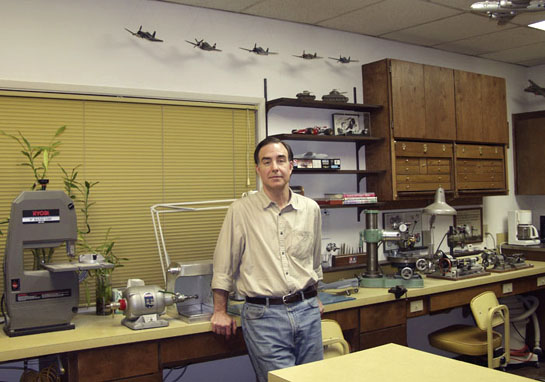
Paul Budzik in his shop. Look all that equipment!
Large Scale Planes: First off thanks for taking your time to talk with us, Paul. Could you tell us a little bit about yourself please?
Paul Budzik: I’m a practicing dentist in my mid ’50s, very happily married, and living in central California. I have been afflicted with a fondness for miniatures for as long as I can remember. After finishing dental school, I was introduced into a circle of very skilled model makers and things really got out of hand. Now I live day to day, only a shadow of my former self.
LSP: When was your first plastic model experience? Do you remember the subject?
PB: If you don’t count the time I broke the nose wheel off a Revell DC-7 and skillfully repaired it with a glob of modeling clay, I would say I was about 5 or 6. I can remember working on Revell’s “Flying Dragon” B-25 kit with my Dad. He built a number of the early kits, and although I was interested, it seems like the first one that I was invited to participate in was the B-25.
LSP: What are your primary interests in plastic modeling? Any particular reason for that?
PB: As far as subjects, I’ve been interested in most everything. Over the years it has shifted between aircraft, ships (mostly sailing ships), railroading, and cars. I’ve built some armor, but for the most part they have been kits. Although, back in the mid eighties, I did some scale drawings for an M-12 which I had partially completed and that’s about as far as that got. I probably choose my subjects based on aesthetics and sentimentality. I’ll probably never build a model of a Brewster Buffalo ( apologies in advance to both of the fans of this aircraft ).
LSP: Are you a professional modeler?
PB: I would not consider myself a professional, although at certain times I have contemplated that option. Certainly over the years, I have sold a model or two and received money for particular custom work but I don’t make my living by making models.
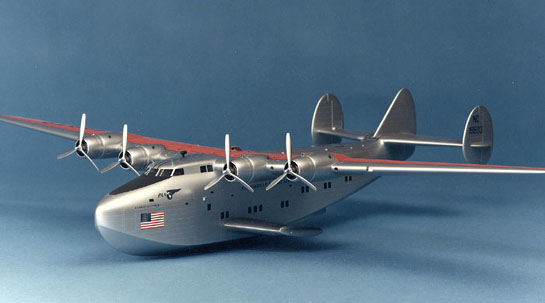
Scratch built Boeing 314 in 1/72. Construction article in May 1993 FineScale Modeler.
LSP: About how many models have you built during your career? Are you still building models?
PB: In all honesty, I wouldn’t have a clue how many models I have built over the years. I still do some building, but at this point it is strictly for my own pleasure. But you never know, that could change tomorrow.
LSP: Would you mind sharing one or two of your favorite modeling tips with us?
PB: On a general level, tip number one would be to keep it fun. If you’re finding yourself using the term “work” for what you’re doing, maybe make some changes. From the “macro” view, get a perspective on what you’re building. Is this, as John Alcorn would term it, your “magnum opus” or a ceiling hanger. I don’t believe on spending time building what people can’t see. And for me, this usually means without the aid of a 2000 watt halogen bulb and magnifying glass, or showing folks photos of what is buried inside. Rather I would suggest spending time on surface structure and detail. Get your contours correct, keep visible cross-sections and edges as close to scale thickness as possible, strive for scale thickness panel lines, and be conscious of the textures of the prototype materials and finishes. I believe you want the model to have a scale presence when viewed from a normal distance.
Also, don’t be afraid to experiment, but don’t do it on your actual project. Whatever it is, if you’re doing it for the first time, try it on a spare or scrap. If I’m working from a kit, I usually have two or three because it rarely comes out right the first time. So plan for that and practice, be patient and don’t get frustrated.
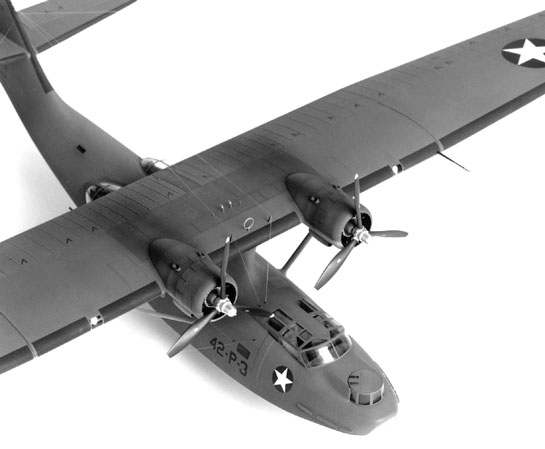
Scratch built PBY in 1/48. Construction article in September 1990 FineScale Modeler...
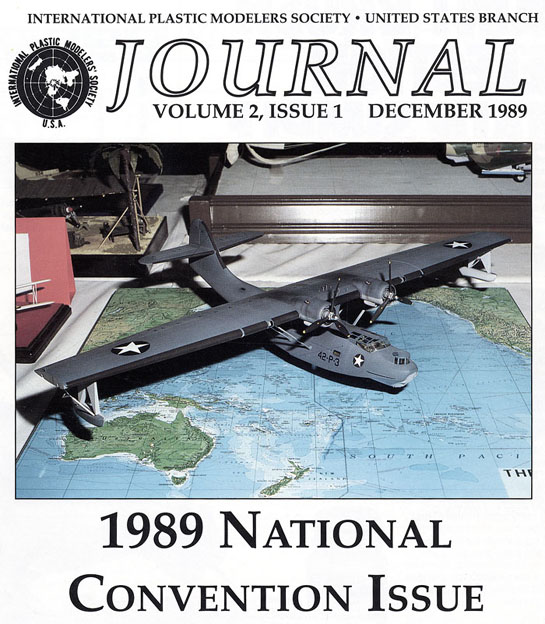
...The PBY won Best of Show at the IPMS Nationals in 1989.
LSP: Do you like to weather your models or you prefer them ´brand new´? If you like weathering, what’s your approach?
PB: I usually apply light to moderate weathering on my aircraft. I prefer to keep it very subtle. I don’t care much for the current fad of pre-shading; many times it seems overdone. In contrast, my railroad models can be heavily weathered while my automobiles are pristine.
On aircraft, I apply my basic finishes first only making considerations for faded paint by lightening the base colors. After the markings are applied, I will weather with a combination of airbrushing and dry brushing.
LSP: Enamels or acrylics? Any preference?
PB: I usually paint with lacquer primers and Floquil. I use automobile finishes on my auto models. For white, I generally use a white lacquer because it won’t yellow. Someday when I run out of my stash of lacquer, I’ll switch over to acrylics.
LSP: NMF (natural metal finish)... which method/paint?
PB: I usually use Alclad over a polished gray lacquer primer. Sometimes I’ve used Floquil silver with a bit of Testor’s silver enamel added to slow the dry time and smooth out the surface, but it isn’t hard enough to scribe into (ed. note: see his scribing method below. You won´t believe!).
LSP: Clear coats (gloss and flat)...which brand?
PB: For flat surfaces, I use Testor’s Dullcote. Sometimes I will add a bit of extra flatting base to the mixture, but not too much or you can get a haze. Flatting base can be purchased from an auto paint store. It is added to auto paints to produce a flat finish. It works well because of the solvents in Dullcote. For high gloss finishes, I use polyurethane.
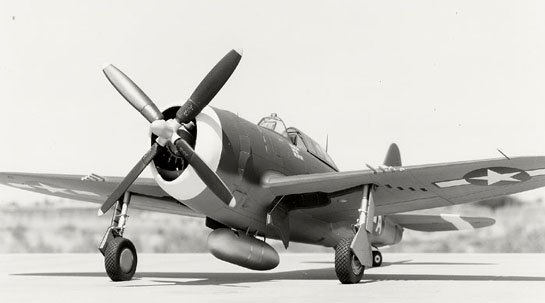
P-47 in 1/32, reworked Revell kit. Construction article in February 1993 FineScale Modeler.
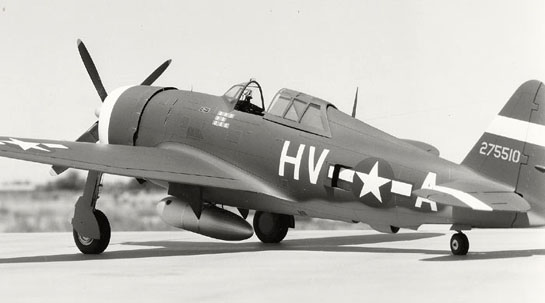
Additional view of P-47.
LSP: Which airbrush do you use? Compressor or CO2? Any special recipe on pressure and thinning ratio? Do you ever brush paint?
PB: I use an air compressor with filters and a dryer. I have a number of airbrushes partly because I’m crazed. (My first airbrush was a Paasche F) Most of the time I will use a Paasche H for my primers, but if it is a big project, I might use my Binks detail gun (used for shooting jams on automobiles). For general parts and sub-assemblies I will use a double action Badger, because the parts are cheap and I am using them frequently during construction. I may not totally disassemble the airbrush to clean them each time I use them. Sometimes I will just run some thinner through them and then squirt it off with one of my Paasche H’s loaded with thinner. (This is not to say that I value the Badgers less or that they are cheaply made.) For final finishes I always use a double action brush appropriate for the size of the model. The objective is to be able to lay enough material on the surface so that you can overlap your passes without it flashing too quickly. For this I will use an Iwata, Thayer and Chandler model C, or Paasche V, all of which are fitted with large tips. I will adjust pressure so that I use the minimum amount of air for good atomization and move the material without extreme overspray. This is generally anywhere between 18 and 25 lbs of pressure. Again, I never apply any paint to the model until I have thoroughly tested and adjusted the airbrush and mixture on a scrap piece. I never spray in my shop; usually I spray outside. My compressor is contained in a roll around bench that I can move outside. I always wear a respirator type mask and latex gloves. I try to make things as convenient as possible so all my hoses are fitted with quick change fittings and I have adapted many of my airbrushes to use 35mm film canisters.
I use a brush for painting small details and touch-up.
LSP: What is your approach to apply decals (including when applied over NMF)? Do you use to paint your markings?
PB: I usually apply my decals right on the final painted surface that I have rubbed out with 1200 grit wet and dry. I will trim the film as close to the graphic as possible. The decal is wet in warm water and slid onto the surface of the model with Microset (blue). When in position, I will lightly blot off the excess Microset and follow with several applications of Microsol (red). Finally I will really melt the decal down with an application of Solvaset. After the decals have set, I wash off the surfaces and clear coat.
If I’m painting on markings, I will use Floquil or lacquer that I rub out as thin as possible.
LSP: Do you like to use detail (photo-etched and/or resin) sets, or you always do everything from scratch?
PB: If there is something available of suitable quality, I will use it. I don’t like re-inventing the wheel.
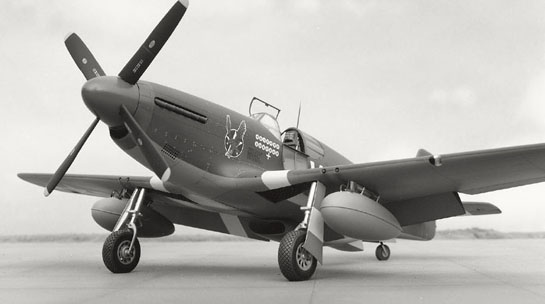
P-51B in 1/32, conversion of Hasegawa kit. Construction article in FineScale Modeler special called Modeling WWII published in January 1995.
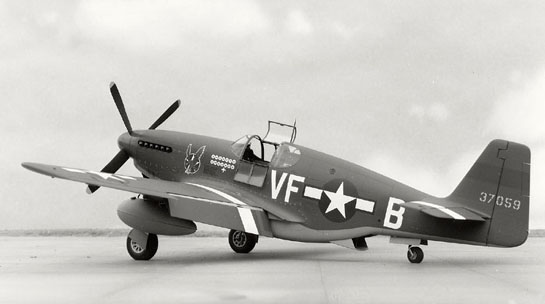
Additional view of P-51B.
LSP: You have any preferences about model manufacturers in the different mediums? If so, why?
PB: In general, I’ve usually found Tamiya’s stuff to be the most well thought out and best fitting of the injection kits, but I have encountered some very nice examples from other manufacturers. However, I do not like the current trend of recessed panel lines. In my opinion, they are way out of scale. Because I add all my own surface detail, I would prefer nothing. Just give me the correct contours and dimensions. And while you’re at it, mold them with the doors shut (a la Monogram Mosquito) since most of my kits wind up on the ceiling. After all, they don’t call the AIRplanes for nothing.
LSP: What types of modeling putty do you generally use?
PB: For filler, I use a mixture of Zap-A-Gap and dental resin powder. Somewhat like mixing Zap-A-Gap with microballoons. 3M’s Acryl Blue is nice, but it softens under lacquer primer.
LSP: Do you make molds of your scratchbuild parts to save work in future (similar) projects?
PB: Yes.
LSP: Do you follow any special (personal) procedure during the construction of a model? How do you start a new modeling project? What impels you to choose a given subject?
PB: I really can’t say why certain subjects are more motivating. However, they always start with research. During the research phase, I am also brainstorming how certain parts will need to be fabricated. Some projects might get scrapped at this phase because I just haven’t thought of a good construction method (like the corrugations on a Martin M-130). If I have to draw plans, then I sort a lot of it out then. If I am kit bashing, then I will check the dimensions of the kit and see what I have to change.
In the case of aircraft, I usually assemble all the basic structures with jigs so that proper alignment is maintained. After everything is together, I will tweak my final contours, fillets, cowlings, spinners, etc. The model is primed and sanded until everything looks right. The raised details and panels are applied. Any glazing is masked off and the final colors are shot. Overspray between colors is removed with a white 3M scuff pad. After all the color coats have been applied, the model is set aside to dry for enough days until the thinner smell has gone away. The surfaces are wet sanded with 1200 grit paper. It is at this stage that I scribe in my panel lines. Decals follow with the final clear coat and weathering.
LSP: You mean you scribe the panel lines AFTER painting???
PB: Yes, I scribe my panel lines into my final paint. You use a very light touch and scribe just through the paint into the gray primer underneath. You only get one shot at it so you can’t make any mistakes. But what you get are these incredibly sharp and fine panel lines. The most time consuming project that I did this way was the Boeing 314. But there is no other way to get a halfway acceptable panel line in 1/72. Now if it is frequently removed panel or door, I might have scribed it into the model after priming but before painting. I would scribe deeper creating more width.
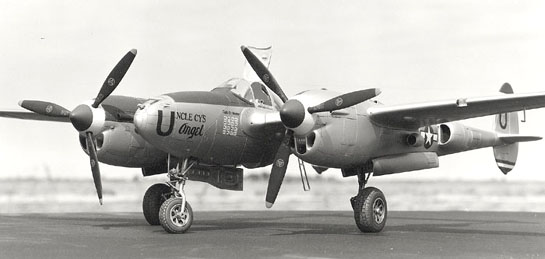
P-38 in 1/32, reworked Revell kit.
LSP: Do you have, like many of us, piles of unassembled kits? If so, about how many?
PB: Yes and I don’t want to know how many.
LSP: Do you work in more than one subject at the same time?
PB: Not seriously. If I put something away, it can stay put away for a very long time. There are usually too many bits to remember and it is hard to keep track of more than one project at a time. Also, working on more than one thing at a time feels too much like production work.
LSP: What is your average time to finish a model (researching and building)?
PB: I never keep track
LSP: In what you have been working lately? Any future projects in sight?
PB: I’ve got a scratch 1/32 Hawker Tempest V that I keep threatening to finish, but that main gear makes me crazy, (thank you Sidney Camm).
LSP: Do you attend (or used to attend) regularly to modeling contests?
PB: I used to, but I pretty much dropped out of contests.
LSP: Are you affiliate to IPMS?
PB: No.
LSP: Do you have an all time favorite aircraft? Which one? Anything you care to model a number of times?
PB: I think the most beautiful aircraft ever produced was the Lockheed Constellation and I’ve only built one when I was about 12. It’s a future project as a companion to my Boeing 314.
LSP: What are your other interests in real life?
PB: Cycling, hot rods, computers, music.
LSP: It doesn’t seem like kids are involved in modeling like when we were kids, what is your personal opinion about the future of our hobby? What do you think of the future of our scale in the hobby for all types of kits (injected, resin, etc.) and aftermarket items?
PB: I think scale modeling hit its zenith years ago. I’m sure there will always be some interest, but I’m afraid it will only become more limited here in the USA. If the interest is maintained in Asia, we will probably continue to see new subjects.
LSP: Well Paul, congratulations for your modeling work. Your masterpieces continue to inspire us all. Again, thank you for taking some of your spare time to talk to us. It is really appreciated. Would you want to say something special to the Large Scale Planes readers?
PB: Yes, I want to take the time to publicly thank all those folks who have helped and inspired me through the years. Most of what I know, I’ve learned from others. Some things I figured out for myself and I hope I have been able to share some of it through my magazine articles. However, some people have been more influential:
My mother when I was about 4 and driving her crazy on a rainy day, “Can’t you just do something constructive?”
Some years later my Dad, “Instead of building a lot of bad models, why don’t you slow down and make a few good models”.
And the three fellows in the picture below who I had the privilege of calling friends. The photo was an impromptu shot that I took back around 1979 when photographing the MG-34 for a future modeling project. From left to right they are: Harry Parker, Oscar Neubert, and John Anderson. Harry and John were the owners of a Cal-Scale. They manufactured some of the finest lost wax brass castings ever produced for model railroading. Many of which are still in production today. Oscar was simply one of the best modeler/machinist that I have ever met and it was my good fortune that he somehow took a shine to me. Whenever I feel a lack of motivation during a modeling project, I can still hear Oscar say, “aw, come on doc”.
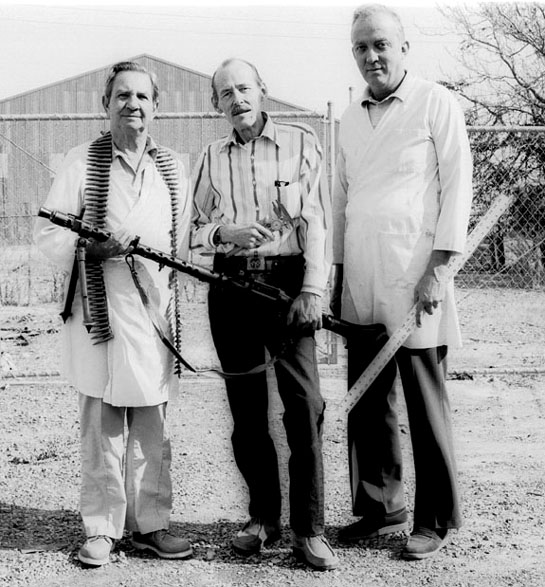
Three major influences to Paul Budzik: From left - Harry Parker, Oscar Neubert, John Anderson.
© Large Scale Planes and Paul Budzik 2004
This article was published on Wednesday, July 20 2011; Last modified on Saturday, May 14 2016
